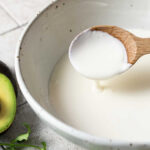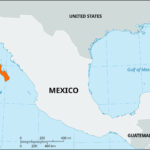Why can’t you drink water in Mexico? You absolutely can’t drink tap water in Mexico due to concerns about water quality and sanitation, but don’t let that deter you from experiencing the country’s vibrant culture and stunning destinations as a traveler. Gaymexico.net is here to guide you through navigating Mexico safely and enjoyably, especially concerning the water situation. By understanding the reasons behind this issue and taking the necessary precautions, you can stay healthy and fully immerse yourself in the beauty and excitement Mexico offers, including information for the LGBTQ+ community. We will explore filtration systems, water purification, and safe drinking alternatives in the queer scene.
1. Understanding The Risks: Why Tap Water Is Off-Limits
You cannot drink tap water in Mexico primarily due to potential contamination in the municipal water systems, old plumbing infrastructure, and the storage methods used in individual properties. While water treatment facilities strive to provide safe water, contamination can occur along the way, making it unsafe for drinking.
Here’s a deeper look into the factors contributing to this issue:
- Contaminated Regional Water Delivery Systems: Antiquated infrastructure and leaky pipes can introduce bacteria, viruses, and other harmful contaminants into the water supply as it travels from treatment plants to your tap.
- Unmaintained Household Plumbing: Older buildings often have outdated plumbing systems with rusty pipes, which can leach lead and other metals into the water, posing health risks.
- Unsanitary Water Storage Systems: Many homes and businesses in Mexico rely on cisterns (underground storage tanks) and “tinacos” (rooftop water tanks) to store water. If these tanks are not properly cleaned and maintained, they can become breeding grounds for bacteria and other microorganisms.
1.1 What Contaminants Are Typically Found In Mexican Tap Water?
Mexican tap water can contain a cocktail of contaminants that can lead to illness. These include:
- Bacteria: Coliform bacteria, including E. coli, are common culprits causing gastrointestinal distress.
- Viruses: Hepatitis A and norovirus can also be present, leading to more severe health issues.
- Parasites: Giardia and Cryptosporidium are parasites that can cause diarrhea, vomiting, and stomach cramps.
- Heavy Metals: Lead and other heavy metals from old pipes can contaminate the water, posing long-term health risks.
1.2 Traveler’s Diarrhea: The Unwelcome Souvenir
Consuming contaminated water can lead to traveler’s diarrhea, also known as “Montezuma’s Revenge.” Symptoms can include nausea, vomiting, abdominal cramps, and diarrhea, which can quickly ruin your vacation.
2. Who Drinks Tap Water In Mexico?
No, most people who live in Mexico do not drink tap water. Mexico has the highest rate of private bottled water consumption in the world because the vast majority of the population distrusts the water coming out of the tap for human consumption.
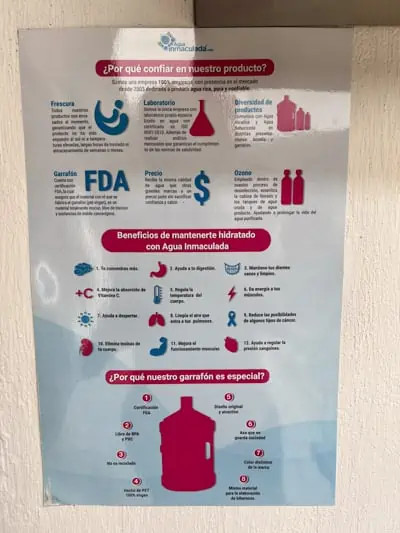
2.1 Are There Any Exceptions?
While it’s generally not recommended, there might be some exceptions. For example, individuals living off-grid may have access to well water or natural springs deemed safe after proper testing. However, this is not the norm.
2.2 What About Locals?
Locals are well aware of the risks associated with tap water and typically avoid drinking it. Instead, they rely on bottled water, purified water delivery services, or home filtration systems.
3. Safe Alternatives: Staying Hydrated Without The Risk
Fortunately, there are numerous safe alternatives to tap water readily available throughout Mexico. Understanding these options will allow you to stay hydrated without risking your health.
3.1 Bottled Water: The Most Popular Choice
Bottled water is widely available in Mexico and is the most common alternative to tap water. You can find it in various sizes, from small individual bottles to large 5-gallon jugs.
- Where to Buy: Bottled water is sold nearly everywhere in Mexico, including supermarkets, grocery stores, pharmacies, convenience stores (“abarotes”), and water kiosks.
- Popular Brands: Some popular brands include Agua Ciel, Bonafont, and Epura.
- Returnable Jugs: Many stores, like Oxxo, offer returnable 5-gallon (20-liter) jugs, which are an environmentally friendly option.
3.2 Purified Water Delivery Services: Convenient and Reliable
Many companies in Mexico specialize in delivering purified water directly to your home or office. This is a convenient and reliable option, especially for longer stays.
- How It Works: These companies typically deliver water in large 5-gallon jugs, which you can dispense using a water cooler.
- Benefits: Purified water delivery services offer a consistent supply of safe drinking water and often provide better-tasting water than some bottled brands.
3.3 Home Filtration Systems: A Long-Term Solution
For those planning to stay in Mexico long-term, installing a home filtration system can be a worthwhile investment.
- Types of Systems: Options range from basic filters that remove sediment to advanced systems with multiple stages of filtration, reverse osmosis, and UV light disinfection.
- Maintenance: Regular maintenance is crucial to ensure the system’s effectiveness. Filters need to be replaced regularly, and the system should be professionally serviced periodically.
- Cost: Professional water filtration systems start at around $500 pesos per month.
3.4 Boiling Water: An Emergency Solution
In emergency situations, boiling water can make it safe for consumption.
- How to Boil: Bring the water to a rolling boil and maintain that temperature for at least one minute to kill bacteria and viruses.
- Limitations: Boiling water will not remove minerals or improve the taste, but it will eliminate harmful pathogens.
4. Navigating Dining Out: What To Ask For
Eating at restaurants in Mexico can be a delightful experience, but it’s essential to be mindful of the water used in food preparation and drinks.
4.1 Ice: A Potential Hazard
Ice can be a source of contamination if made with tap water.
- Ask Questions: Inquire whether the restaurant uses purified water to make its ice. Reputable establishments typically purchase ice from reputable ice makers that use purified water.
- Look for Signs: A busy restaurant with a steady stream of customers is generally a good sign that they adhere to basic sanitary standards.
4.2 Drinks: Be Mindful Of The Water Source
Be cautious of drinks that may contain tap water, such as:
- Aguas Frescas: These refreshing fruit drinks are often made with water. Make sure the vendor uses purified water.
- Coffee: Avoid making coffee with tap water, as the water temperature may not be high enough to kill all bacteria.
- Other Beverages: When in doubt, ask whether the beverage is made with purified water.
4.3 What If a Restaurant Serves Tap Water?
Serving tap water to customers is generally a bad business practice in Mexico, as it can lead to illness and a loss of customers. Most restaurants will serve bottled water or water from a purified source if requested.
5. Daily Hygiene: Protecting Yourself Beyond Drinking Water
While drinking water is the primary concern, it’s also essential to take precautions when using tap water for daily hygiene.
5.1 Brushing Your Teeth: Rinse With Care
Brushing your teeth with tap water is generally safe as long as you avoid swallowing the water.
- Rinse with Bottled Water: If you’re concerned or have young children who may swallow water, use bottled water to brush your teeth.
- Hotel Precautions: When staying in hotels, it’s always best to err on the side of caution, as you may not know the maintenance schedule of their water systems.
5.2 Showering: Minimizing Exposure
Showering with tap water is generally safe, as the water is not ingested. However, it’s best to avoid opening your mouth and swallowing water while showering.
6. What About Ice In Mexico?
This is where things get a little more complicated in Mexico. Successful restaurants almost exclusively purchase their ice from reputable ice makers that use purified water. The best restaurants would never consider using tap water in their ice or their drinks because people are going to get sick and they will not come back. The clearest sign that a restaurant is following basic sanitary standards is that there are a lot of people eating there.
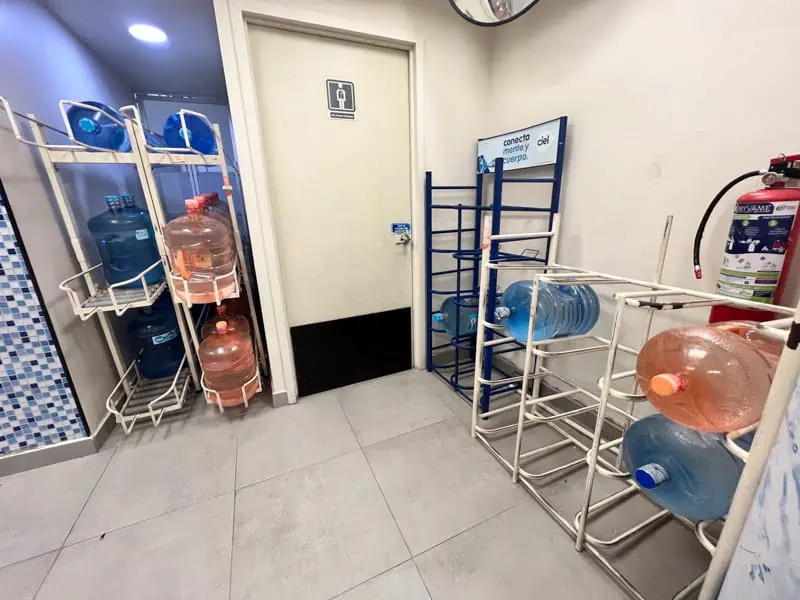 Water jugs for sale at Oxxo
Water jugs for sale at Oxxo
6.1 Street Vendors
Be cautious about buying food from street vendors that do not take basic hygiene seriously. At a minimum, a street vendor should have access to a place to wash their hands. Look for famous, busy street food stands that people return to often.
7. Can I Make Coffee With Tap Water In Mexico?
No, don’t make coffee with tap water. Tap water tastes horrible and will ruin good coffee. The ideal temperature for making coffee is way below boiling. If the water is contaminated, simply warming it will not kill all the bacteria. Water must reach boiling temperature and sustain that temperature for at least one minute to kill all the potential pathogens.
8. Is Tap Water Safe To Drink In Hotel Rooms In Mexico?
No, do not drink the tap water in a hotel. Hotels provide at least a small amount of bottled water for each room. Additionally, the hotel will have 5-gallon jugs around somewhere. Always carry a reusable water bottle, an insulated tumbler with a top, that I can refill.
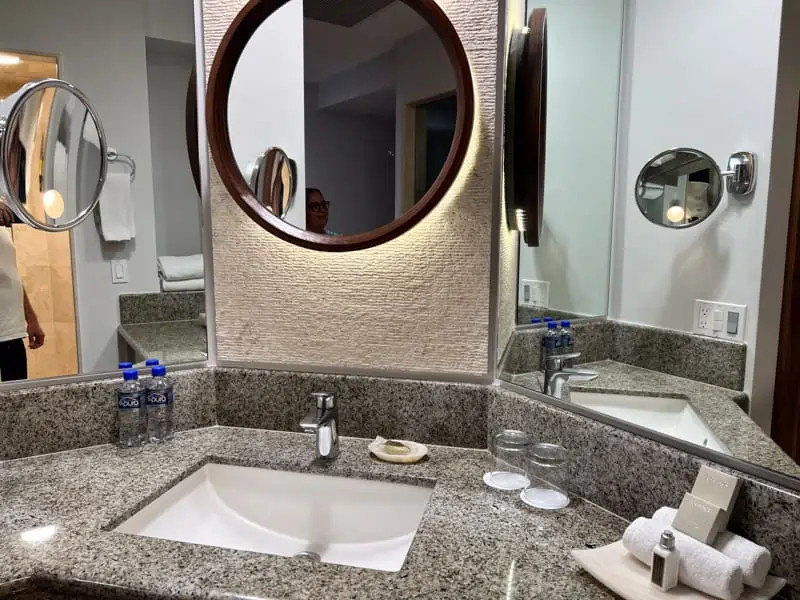 do not drink hotel tap water in Mexico
do not drink hotel tap water in Mexico
9. Important Spanish Phrases For Water Safety
Knowing a few basic Spanish phrases can be helpful when navigating the water situation in Mexico.
- Agua Potable: Drinkable water
- Agua No-Potable: Not drinkable
- Agua Purificada: Purified water
- ¿Es seguro tomar el agua de la llave?: Is it safe to drink the tap water?
- ¿Usan agua purificada para hacer el hielo?: Do you use purified water to make the ice?
10. Gay Mexico: Staying Safe And Informed
For LGBTQ+ travelers, safety is paramount. Gaymexico.net offers a wealth of information and resources to help you navigate Mexico confidently.
10.1 Accessing Reliable Information
Gaymexico.net provides up-to-date information on LGBTQ+-friendly destinations, events, and businesses in Mexico.
10.2 Connecting With The Community
Connect with local LGBTQ+ communities for insider tips and recommendations.
10.3 Staying Informed
Stay informed about local laws, customs, and safety precautions.
11. Safe LGBTQ+ Destinations in Mexico
Mexico offers a variety of welcoming destinations for LGBTQ+ travelers.
11.1 Puerto Vallarta
Known for its vibrant gay scene, Puerto Vallarta offers beautiful beaches, gay-friendly resorts, and lively nightlife.
11.2 Mexico City
The capital city boasts a thriving LGBTQ+ community, with numerous gay bars, clubs, and cultural events.
11.3 Cancun
While primarily known for its resorts, Cancun also has a growing LGBTQ+ scene, with several gay-friendly hotels and bars.
12. How To Find Bottled Water In Mexico?
Bottled water is sold nearly everywhere in Mexico. There are tons of different-sized bottles but the most common is the returnable 5-gallon (20-liter) jug. 5-gallon jugs can be returned to the Oxxo for a new one. There are usually at least two companies supplying each Oxxo with water. Supermarkets, grocery stores, pharmacies, convenience stores (abarotes), and tons of other retailers sell water. There are water kiosks set up all over my neighborhood where you can put some coins into a machine and fill up a jug with either normal water or alkaline water. There is a water kiosk behind my favorite taco shop so I can kill two birds with one stone (matar dos pajaros con un tiro).
13. Common Household Water System Best Practices
Water comes into a house from the street at a trickle. This trickle of water is collected into an underground cistern that is usually made out of concrete and needs regular cleaning. A pump lifts water from the cistern to a water tank on the roof called a tinaco. Water filters are usually placed near the tinaco (rooftop water tank) and they need to be replaced every six months. Each house is different but the tinaco filtration system can be complex or it can be simple. The more complex the system the more expensive it is to replace the filters.
Many houses will add a chlorine pill to the Tinaco every few months to kill any bacteria and or viruses that could find their way into the tank. Many times, the water coming out of the faucets in a house has just a hint of a chlorine smell.
14. Water Scarcity Issues In Mexico
Every time I go home to San Diego, I am horrified by the taste of the water that comes out of the tap. In Mexico, I drink water that is purified by the Coca-Cola Company and delivered to my door for a fee. It tastes better than the tap water in most of California. Water scarcity is only going to exacerbate these crises in the future.
15. Staying Healthy And Enjoying Your Trip
By taking these precautions, you can minimize your risk of getting sick from contaminated water and fully enjoy your trip to Mexico.
15.1 Key Takeaways
- Avoid tap water: Stick to bottled water, purified water, or boiled water.
- Be mindful of ice: Inquire about the water source used to make ice.
- Exercise caution when dining out: Ask about the water used in food and drinks.
- Practice good hygiene: Use bottled water for brushing your teeth if concerned.
- Stay informed: Consult Gaymexico.net for up-to-date information and resources.
15.2 Additional Tips
- Pack essential medications: Bring any necessary medications for gastrointestinal issues.
- Consider travel insurance: Travel insurance can cover medical expenses and trip interruptions.
- Trust your instincts: If something doesn’t seem right, err on the side of caution.
16. Conclusion: Embrace The Adventure With Confidence
While the water situation in Mexico may seem daunting, it doesn’t have to hinder your travel plans. By understanding the risks and taking the necessary precautions, you can stay healthy and enjoy all that Mexico has to offer. From the stunning beaches of Puerto Vallarta to the vibrant nightlife of Mexico City, adventure awaits!
Ready to explore Mexico with confidence? Visit Gaymexico.net for comprehensive travel guides, LGBTQ+ resources, and insider tips. Connect with the community, discover hidden gems, and create unforgettable memories in this beautiful and welcoming country.
Remember, a little preparation goes a long way. Embrace the adventure, stay safe, and ¡disfruta tu viaje!
Frequently Asked Questions (FAQs)
1. Is it safe to drink tap water in Mexico?
No, it is generally not safe to drink tap water in Mexico due to potential contamination issues.
2. What are the main reasons why tap water is unsafe in Mexico?
The main reasons include contaminated regional water delivery systems, unmaintained household plumbing, and unsanitary water storage systems.
3. What are some safe alternatives to tap water in Mexico?
Safe alternatives include bottled water, purified water delivery services, home filtration systems, and boiled water (in emergencies).
4. Can I use tap water to brush my teeth in Mexico?
Yes, as long as you avoid swallowing the water. Consider using bottled water if you’re concerned or have young children.
5. Is it safe to drink ice in Mexico?
It depends. Inquire whether restaurants use purified water to make ice. Reputable establishments typically do. Be cautious with street vendors.
6. Can I make coffee with tap water in Mexico?
No, it’s not recommended. The water temperature may not be high enough to kill all bacteria.
7. What should I do if I accidentally drink tap water in Mexico?
Monitor yourself for symptoms of traveler’s diarrhea. If symptoms develop, seek medical attention if necessary.
8. Are there any cities in Mexico where tap water is safe to drink?
While some cities have improved water supplies, it’s generally best to avoid tap water throughout Mexico.
9. How can Gaymexico.net help LGBTQ+ travelers stay safe in Mexico?
gaymexico.net provides up-to-date information on LGBTQ+-friendly destinations, events, and businesses, as well as safety tips and resources.
10. What are some LGBTQ+-friendly destinations in Mexico?
Some popular destinations include Puerto Vallarta, Mexico City, and Cancun, all offering vibrant LGBTQ+ scenes and welcoming environments.
